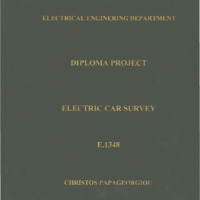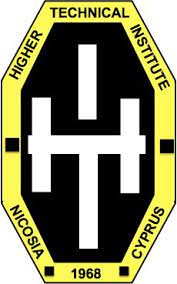Electric car survey
- Τίτλος
-
Electric car survey
- Θέμα
- Electric automobiles
- Electric automobiles--Research
- Electric automobiles--Electric equipment
- Δημιουργός
-
Papageorgiou, Christos
- Πηγή
-
Papageorgiou Christos
- Το πλήρες κείμενο είναι διαθέσιμο από το Υπουργείο Ενέργειας, Εμπορίου Βιομηχανίας και Τουρισμού.
- Εκδότης
- Library of Cyprus University of Technology
- Ημερομηνία
- 2004
- Συνεισφέρων
- Marouchos, Ch.
- Δικαιώματα
- Απαγορεύεται η δημοσίευση ή αναπαραγωγή, ηλεκτρονική ή άλλη χωρίς τη γραπτή συγκατάθεση του δημιουργού και κάτοχου των πνευματικών δικαιωμάτων.
- Μορφή
- Γλώσσα
- en
- Τύπος
- text
- Αναγνωριστικό
-
EED0563
- Σύνοψη
-
An electric car is an automobile propelled by one or more electric motors, drawing power from an onboard source of electricity. Electric cars are mechanically simpler and more durable than gasoline-powered cars. They produce less pollution than gasoline-powered cars do.
From the outside, you would probably have no idea that a car is electric. In most cases, electric cars are created by converting a gasoline-powered car, and in that case it is impossible to tell. When you drive an electric car, often the only thing that could make you understand its true nature is the fact that it is nearly silent.
An electric car stores its energy on board-typically in batteries, but alternatively with capacitors or flywheel storage devices. Or it may generate energy using a fuel cell or generator. A fuel cell is a specialized form of battery that combines hydrogen with oxygen in a chemical reaction that produces electricity and water vapor. Most current versions of electric cars use some combination of these energy sources. "Pure" electric cars, however, run only on batteries and need a charger to replenish the battery's power from an electrical outlet.
The Fuel Cell is a device in which the energy of a chemical reaction is converted directly into electricity. Unlike a battery, a fuel cell does not run down; it operates as long as fuel and an oxidant are supplied continuously from outside the cell. Several companies are developing fuel cells that they hope will replace conventional internalcombustion engines in automobiles over the next few decades.
Hydrogen fuel cells hold great promise as low-pollution automobile engines if certain difficulties can be overcome. Water, the only waste product of a hydrogen-oxygen fuel cell, is nonpolluting and can be used to cool the engine. The oxygen the cells need is readily available in air. Hydrogen, however, is not so readily available, and there is no existing delivery system to convey hydrogen to all the places people would need it to power their cars. In addition, pure hydrogen is not abundant enough to provide power for all the cars on the road today. Instead, hydrogen would need to be extracted from other substances, a process that requires energy and produces pollutants.
Most electric cars use lead-acid batteries, but new types of batteries, including zincchlorine, nickel metal hydride, and sodium-sulfur, are becoming more common. The motor of an electric car harnesses the battery's electrical energy by converting it to kinetic energy. The driver simply switches on the power, selects "Forward" or "Reverse" with another switch, and steps on the accelerator pedal.
A more recent development is the hybrid electric vehicle (HEV), which uses both an electric motor or motors and a gasoline or diesel engine that charges the batteries in order to extend the car's range and often to provide additional power. Regardless of the energy source, an electric car needs a controller, which is connected to the accelerator pedal, for directing the flow of electricity from the energy source to the motor.
While the internal-combustion engine of a conventional car has many moving parts and must convert the linear motion of pistons and rods into rotary motion at the wheels, an electric motor has only a single rotating element. Like a gasoline-powered car, an electric car has a system (called a power train) of gears, shafts, and joints that transmit motion from the motor to the car wheels. Most electric cars do not have clutches or multispeed transmissions. In order to go backward, the flow of electricity through the motor is reversed, changing the rotation of the motor and causing the power train to make the wheels rotate in the other direction.
Most electric cars have a regenerative braking system-the braking system acts as a battery charger. When drivers ease up on the accelerator or step on a brake pedal, the drive motor acts as a generator and converts the vehicle's momentum back into electricity and stores it in the battery. Converting the kinetic energy into electric energy slows the car. Electric cars also have a brake pedal and a traditional braking system, which uses friction to slow the vehicle for quick and emergency stopping. These friction brakes convert kinetic energy to heat.
In the next chapters you will read about the evolution of electric cars, from the early carts to the modem saloons. I have also studied various ways for powering an electric car, from batteries and fuel cells to solar energy. I describe methods of controlling the car's operation, such as acceleration and breaking and give a brief description of how to convert a normal internal combustion car to an electric one. I have also included some experiments I have done with drivers for ac and dc motors.
- Πολυμέσα
-
 EED0563.pdf
EED0563.pdf
Τμήμα του Electric car survey


